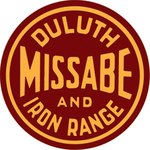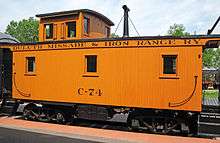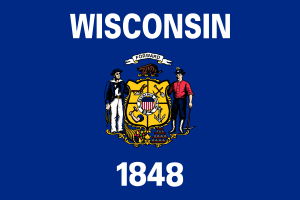Duluth, Missabe and Iron Range Railway
 | |
|
Map of the DM&IR. Solid lines are track still in use; dotted lines are abandoned track. | |
| Reporting mark | DMIR |
|---|---|
| Locale | Saint Louis County / Lake County, Minnesota and Douglas County, Wisconsin |
| Dates of operation | 1874–2011 |
| Track gauge | 4 ft 8 1⁄2 in (1,435 mm) standard gauge |
| Headquarters | Proctor, Minnesota |
The Duluth, Missabe and Iron Range Railway (DM&IR) (reporting mark DMIR) is a railroad operating in northern Minnesota and Wisconsin that hauls iron ore and later taconite to the Great Lakes ports of Duluth and Two Harbors, Minnesota. Control of the railway was acquired on May 10, 2004, by the Canadian National Railway (CN) when it purchased the assets of Great Lakes Transportation.
History

The DM&IR was formed by the merger in 1937 of the Duluth, Missabe and Northern Railway (DM&N) and the Spirit Lake Transfer Railway; the Duluth and Iron Range Rail Road (D&IR) and Interstate Transfer Railway were added in 1938. All of these had been leased by the DM&N since 1930.
The D&IR was formed in 1874 by Charlemagne Tower to haul iron ore from the Minnesota Iron Co. in Tower, Minnesota, to the new Lake Superior port of Two Harbors, Minnesota. The first ore shipment from the Soudan Mine over the D&IR was on July 31, 1884. The D&IR was acquired by Illinois Steel in 1887. In 1901, Illinois Steel became part of the newly formed United States Steel Corporation (USS) and the railway became part of its holdings.
The DM&N was incorporated in 1891 and the first load of iron ore was shipped to Superior, Wisconsin, in October, 1892. (The formation of the railway was necessary after the discovery of high-grade Mesabi iron ore near Mountain Iron, Minnesota by the Seven Iron Men. The D&IR was approached to construct a new branch line, but was not receptive.) The Merritts expanded DM&N by laying track to Duluth, Minnesota, in 1893 and built an ore dock there. The Merritts' shaky financial position, caused in part by building the Duluth expansion, allowed John D. Rockefeller to gain control of the railway in 1894. In 1901, Rockefeller sold the DM&N to USS.
From 1901 to 1938, the two railways were owned by USS and operated separately. Total ore hauled by the two railroads peaked in 1929 at 27.8 million tons (long tons of 2240 lb) and dropped to 1.5 million tons in 1932.
Merger


By July 1938, the two railways merged to form the DM&IR. The two operating divisions, the Missabe and the Iron Range, were based upon the predecessor roads. As the United States began to prepare for the Second World War the iron ore tonnage moving over the Missabe Road more than doubled from a little over 8 million tons in 1938 to over 18 million tons in 1939 and leaped to almost 28 million tons in 1940 and over 37 million tons in 1941.
The first eight of DM&IR's class M 2-8-8-4 Yellowstone locomotives were delivered by Baldwin Locomotive Works in spring 1941. As well as the Yellowstones, the DM&IR had heavy 2-8-8-2 articulateds (also Class M), 2-8-2 Mikados, 2-10-2 Santa Fes, and eventually 2-10-4 Texas types from B&LE. Ore movement was nearly 45 million tons in 1942 and the War Production Board allowed the Missabe to order ten more Yellowstones, delivered in 1943. The 2-8-8-4s were slowly retired in the later half of the '50s and the last remaining served until around 1960.
Dieselization and post-war growth
After World War II, the DM&IR hauled increasing tonnage to the ore docks along Lake Superior reaching a record of over 49 million tons in 1953. That year the first diesel locomotives, EMD SW9s, arrived on the railway. In 1954, a set of Baldwin DR-4-4-1500 "Sharknose" diesels arrived from the Elgin, Joliet and Eastern (a fellow U.S. Steel railroad), though they were returned to Baldwin Locomotive Works when the EJ&E contract expired in 1955. Dieselization continued with the purchase of several EMD SD9 road switchers the following year, while the last revenue steam run occurred in 1961. Passenger service on the Missabe division ended in 1957 and completely ceased system wide in 1961.
| Year | Traffic |
|---|---|
| 1925 | 2115 |
| 1933 | 806 |
| 1944 | 3733 |
| 1960 | 2696 |
| 1970 | 2202 |
The availability of high-quality iron ore was becoming limited; mines and pits were closing across Minnesota's iron ranges. The DM&IR's ore docks in Two Harbors closed in 1963 and did not reopen until 1966. The Missabe Road was saved by the passage on November 3, 1963, of the Taconite Amendment to the Minnesota State Constitution. (The amendment restricted the state's ability to tax a taconite industry for 25 years.) The passage of the amendment accelerated the creation of the taconite mining industry in Northern Minnesota. The Eveleth Taconite Company was formed in 1964 and on April 8, 1966, the SS Edmund Fitzgerald took on the first load of Eveleth taconite pellets, about 23,000 tons. The taconite era on the Missabe had begun.
Ownership and CN merger
In 1988, U.S. Steel, now USX, spun off the DM&IR and their other ore railroads and shipping companies into the subsidiary Transtar, then sold majority control to the Blackstone Group and USX. In 2001, the DM&IR and other holdings were spun off from Transtar into the company Great Lakes Transportation (GLT) which was fully owned by the Blackstone Group. For the first time in over 100 years DM&IR was no longer associated with U.S. Steel. In late 2003, the Blackstone Group agreed to sell GLT to Canadian National Railway and the purchase was finalized on May 10, 2004.
Merger with Wisconsin Central
In December 2011, the Duluth, Missabe & Iron Range Railway was merged into Wisconsin Central Ltd., which is also controlled by Canadian National Railway. This merger was intended to increase efficiency.[1]
Notes
- ↑ "CN merges three US subsidiaries". Railway Gazette International. Retrieved 4 January 2012.
References
- Frank Alexander King (2003). The Missabe Road: The Duluth, Missabe and Iron Range Railway. University of Minnesota Press. ISBN 978-0-8166-4083-6.
External links
| Wikimedia Commons has media related to Duluth, Missabe and Iron Range Railway. |
- Missabe Railroad Historical Society
- DMI&R History (Archived on 19 October 2007 from CN website)
- www.missabe.com/cms/catalog/decals
- DULUTH, MISSABE, AND IRON RANGE RAILWAY: An Inventory of Its Records at the Minnesota Historical Society


